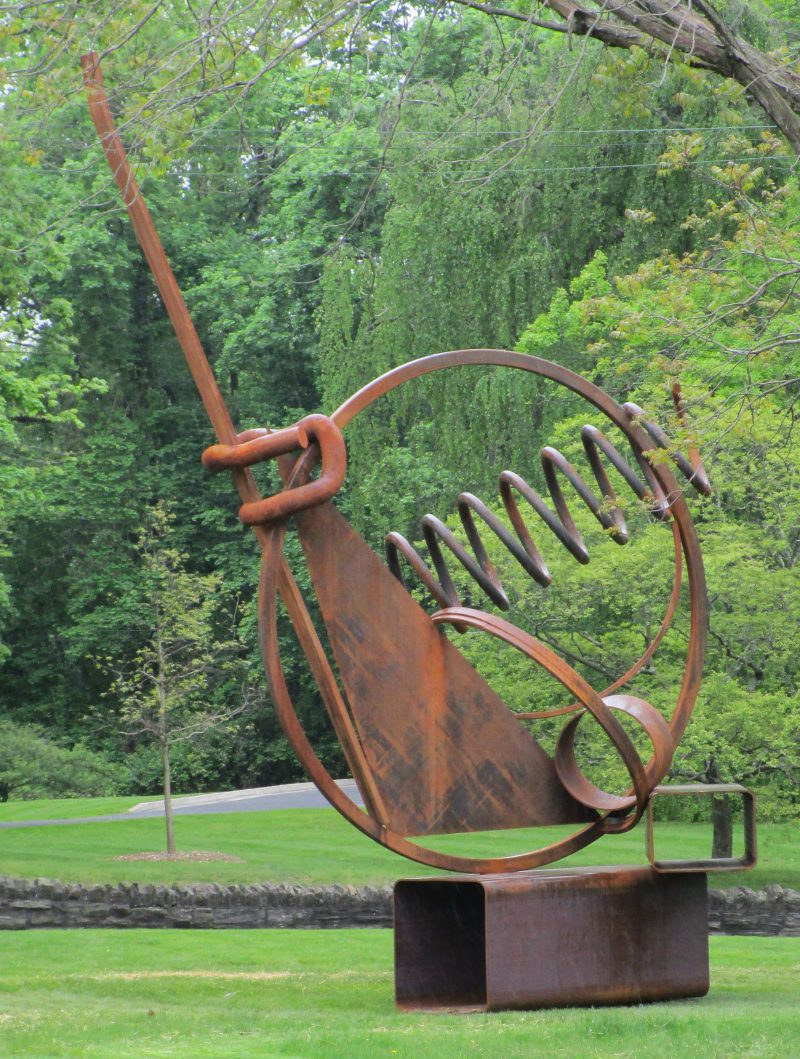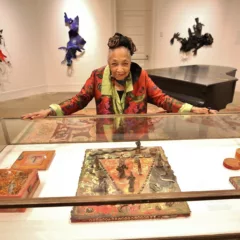
Learning from and about Woodmere
I had the opportunity to tour the Woodmere Art Museum and to chat with its Director, Bill Valerio, on April 6. For those who have not been to the Museum, it is a lovely, spacious environment for viewing art. The grounds likewise are beautiful, and the addition of the newly-installed Dina Wind sculpture, which is pictured above, is monumental. Valerio told me that he is determined to create an environment for the Museum that integrates art and nature, and the Wind piece goes a long way towards accomplishing that goal.
I came away from our meeting April 6 with the impression that Valerio is a thoughtful and imaginative person who is dedicated to engaging the community in the arts. He seems willing to take risks. He has an eye for the overlooked, for the unexpected, and he is committed to promoting local artists who are working outside of the mainstream. When so much of the art world is focused upon celebrities and established artists, and has become international, it is not a small blessing that the Woodmere is focused upon telling the story of the art and artists of Philadelphia.
But before going further, let’s back up for a glimpse of the history of the Museum.
The legacy of Charles Knox Smith
The progenitor of the Woodmere Art Museum, Charles Knox Smith, a businessman, art collector, and God-fearing Presbyterian, was born in 1845 and died in 1916. Smith began his working life as an oil wagon driver and he worked his way up to become a partner in the company. It was the era of John D. Rockefeller and the Standard Oil Company. Smith later acquired an interest in a venture called Amparo Mining, which mined gold and silver in Mexico. In 1898, he bought the mansion on Germantown Avenue for $35,000, which is now the Museum, and he lived there for the remainder of his life. Smith may have begun collecting art under the influence of Albert Rosenthal, a painter, etcher, and lithographer who studied at the Pennsylvania Academy of Fine Arts, and over the years the self-made man amassed a substantial collection consisting primarily of works by lesser-known American and European artists of the 19th century.
The Museum was founded after the death of Smith’s second wife, who lived in the mansion until she died in 1936. In his will, Smith provided that his collection, consisting of paintings, antique rugs, statuary, vases, and art objects, was “to be preserved and maintained for the free use, benefit, and enlightenment of the public as a contribution by me for the use and benefit of the community in which I have lived.”
An extended probate proceeding in the Philadelphia Orphans’ Court followed the death of Smith’s wife. In that proceeding, the Court was asked to determine whether Smith’s designation of “the community in which I have lived” was limited to the Chestnut Hill area, or whether it included the entire Philadelphia area. The Court ultimately decided that it included the entire Philadelphia area, and indeed, since its inception, the Museum has focused upon the work of artists for whom Philadelphia has played a meaningful role in their intellectual lives, and particularly to emerging artists.
The Court also was asked to determine whether the funds Smith allocated in his will to support the Museum, some $200,000, would be sufficient. I was surprised to learn that during those proceedings, the Philadelphia Museum of Art, then under the leadership of J. Stogdell Stokes, aggressively asserted that Smith’s plans for the Museum were, for a variety of reasons, unfeasible. Indeed, the PMA proposed to obtain Smith’s entire collection and to dedicate one of its small galleries to a rotating display of a portion of the collection. The Court ultimately decided against the PMA, and the Woodmere Art Museum was born in the early 1940s under the auspices of the Art League of Germantown and the Chestnut Hill Art Center. The Pennsylvania Academy of Fine Arts assisted those organizations in a consulting role.
I think it is fair to say that the Museum faced many challenges during the first six decades of its existence and struggled to thrive. Indeed, at the outset, one interested party described it as a “Chamber of Horrors.” I was interested to learn that for most of those difficult years the Museum was run by an artist named Edith Emerson. A graduate of PAFA, Emerson was the “life partner” of the acclaimed muralist Violet Oakley. Emerson’s “Portrait of Violet Oakley” is one of the important works of the museum’s permanent collection, which includes works by, among others, Edward Redfield , Daniel Garber, Walter E. Schofield, Benjamin West, Frederic Edwin Church, Violet Oakley and Arthur B. Carles. The catalog of the collection that Smith himself commissioned was dedicated to “the Cause of God and Christ and for the Education, Refinement and Elevation of Mankind.”
New directions
In 2010, the Museum hired William Valerio as Patricia Van Burgh Allison Director and CEO. (Valerio replaced the retiring Michael Schantz, who had been director and CEO for 28 years, since 1981.) Before coming to Woodmere, Valerio was Assistant Director of Administration at the PMA. He attended Williams College, earned a PhD from Yale, specializing in Italian Futurism, and worked at the Queens Museum of Art as a curator before moving to the PMA. My sense is that Valerio inherited an institution that throughout its history has been undercapitalized and has faced challenging budget constraints, and that he has done a remarkable job moving the Museum in a new direction, given the circumstances.
The dynamic and forward-thinking Valerio has breathed fresh life into Woodmere, and today it is a vibrant, progressive museum and cultural and educational center featuring jazz concerts, lectures, and films. The Museum, which also runs art programs in various Philadelphia public schools, is unusually child and family friendly. There is a separate gallery for the artwork of children, the Helen Millard Children’s Gallery, and there is substantial coordination between the Museum’s curatorial and educational departments. At the beginning of Valerio’s tenure, annual attendance at the Museum was approximately 15,000. Last year it was 43,000. And the collection has grown from the original 2,000 works to approximately 6,000.
I thought it would be illuminating to highlight two of the exhibitions that the Museum has put on in the last few years, and then a peek at what’s to come, all of which speak to the exciting direction that Valerio has spearheaded at the Museum.
Women and Biography (2014) presented works from the Museum’s collection exploring the personal and public expression of intimate relationships between artists and their families, partners, children, and one another. The exhibit included works by, among others, Mary Cassatt, Helen Corson, Edith Emerson, Anne Minich, Martha Erlebacher, Elizabeth Shippen Green, Betty Hubbard, Aubrey Levinthal, Mitzi Melnicoff, Catherine Mulligan, Edith Neff, Violet Oakley, Alice Kent Stoddard, Gertrude Fisher-Fishman, Millicent Krouse, Martha Armstrong, and Mickayell Thurin.
We Speak: Black Artists in Philadelphia, 1920s-1970s (2015), a curated show of works from a multitude of sources, featured over 70 paintings, photographs, sculptures, and prints produced by black artists living and working in Philadelphia during the 50-year period, many of whom were, and continue to be, overlooked in the art community. The artists in this notable exhibition included Meta Vaux Warrick Fuller, Barbara Chase-Riboud, Edward Ellis Hughes, Ronald Ayres, Paul F. Keene, Jr., James Brantley, Henry Ossawa Tanner, Benjamin Britt, Charles Aaron Pridgen, Barbara Bullock, Laura Wheeler Waring, Charles Searles, Moe Brooker, John W. Mosley, Ed Jones, and Raymond Steth.
Thomas Hine remarked about the exhibition: “With this show, Woodmere is encouraging its audience to embrace an art that has often been about suffering and struggle. We should be able to see this work not as African American heritage, but as part of the culture of the place where we live. “Art: Black Philadelphia artists, visible at last” (philly.com, December 12, 2015). And Andrea Kirsh, reviewing the show in these pages, noted that: “The exhibition is a fascinating survey of an entire community—one that created its own artistic institutions in the face of neglect, if not outright exclusion by the mainstream Philadelphia art world.”
Going forward, The Woodmere Annual: 75th Juried Exhibition, The Condition of Place opens on June 4, 2016. This show will highlight contemporary work in a wide variety of media by artists living within fifty miles of the Museum. The exhibition focuses on the ways artists consider the theme of “the condition of place.” I haven’t been able to figure out exactly what that means, but the show was juried by Tyler School of Art’s wonderful abstract painter Odili Donald Odita, and will feature scores of exciting local emerging artists.
Finally, Dina Wind’s “Spring & Triangle,” pictured above, gets its official unveiling on June 11, at 3 pm. The 30-foot enlargement of a smaller work of Wind’s fulfills the aspiration of the late artist and art philanthropist to realize her sculpture on a monumental public scale. “Spring & Triangle” sits on the Museum’s front lawn and creates a stunning interaction between the natural environment and the Museum itself. Videos documenting the fabrication and installation of the sculpture can be found on the Museum’s website.
The enormous contribution that Woodmere has made to promoting, preserving, and featuring the art and artists of the Philadelphia region is enhanced by the Museum’s accessibility. Bill Valerio and his team have done an incredible job of figuring out how to invite and welcome the larger community, in all of its diversity, to visit and use Museum. They have, essentially, built a magnificent cultural center of the arts, which serves the entire metropolitan area and benefits us all.
For additional, and far more thorough historical information about the Museum, see Woodmere Art Museum, The First Fifty Years (1990), by Michael G. Dubrow, and “The Pennsylvania Impressionist Legacy,” by Michael Schantz, American Art Review (September–October 2005). John Thornton has also produced a fine overview of the Museum and its history narrated by Bill Valerio: “Welcome to the Woodmere Museum”.
The Woodmere Art Museum at 9201 Germantown Ave. is open Tuesday–Thursday 10 am–5 pm, Friday 10 am–8:45 pm, Saturday 10 am–6 pm, and Sunday 10 am–5 pm.








